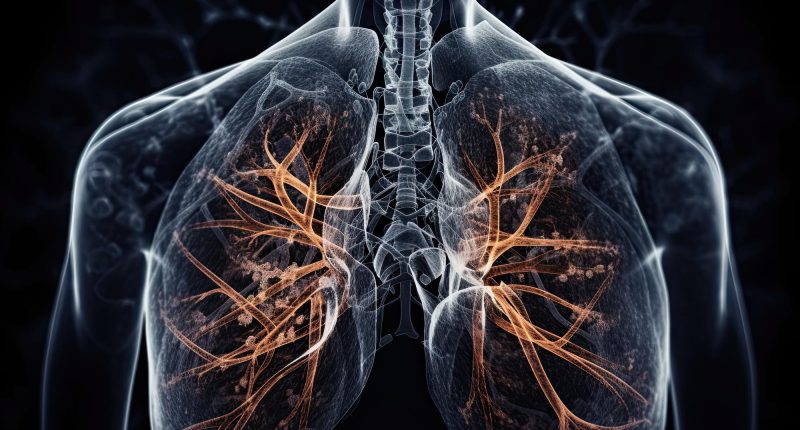Byssinosis, also referred to as brown lung disease, is a respiratory illness that occurs when individuals inhale particles from materials like flax, hemp, and cotton during their work. This condition is categorized as a type of asthma because it arises due to exposure in the workplace.
In the U.S., the prevalence of byssinosis is highest among workers who handle unprocessed cotton, particularly those involved in the initial stages of cotton processing where they open bales. These occupations put individuals at risk of inhaling dust particles that can irritate and damage the lungs over time.
Due to stringent regulations and legal protections in the U.S., cases of byssinosis have become rare. These regulations ensure that employers follow guidelines set by agencies like the Occupational Safety and Health Administration to protect workers from dangerous exposures. However, in growing countries, where such regulations may be less enforced or implemented, byssinosis remains more prevalent. Restricted safety measures and inadequate protective gear in these regions contribute to higher rates of occupational lung diseases among workers exposed to textile and agricultural dust.
Efforts to raise awareness and enforce safety standards globally are crucial in reducing the incidence of byssinosis and similar occupational lung diseases, ensuring safer working conditions for all individuals vulnerable to these respiratory hazards.
Symptoms
Byssinosis symptoms typically begin at the start of the week and tend to enhance by the weekend. However, if you are in contact with the dust fragments for a long time, you might experience symptoms throughout the full week.
These symptoms are the same as those of asthma and involve wheezing, chest tightness, and coughing. In severe cases, you may also feel flu-like signs like fever, joint and muscle pain, tiredness, dry cough, and shivering.
Generally, the signs of byssinosis improve when you are no longer in contact with dust. However, if the exposure continues over time, it can lead to permanent lung damage.
Causes
Byssinosis mainly affects people who work in the textile industry. It happens when workers breathe in dust from cotton, hemp, and raw flax. These particles irritate the lungs, leading to the symptoms of the disease.
Several factors can increase the chance of getting byssinosis. Smoking is one of the main risk factors, as it can make the lungs more vulnerable to the harmful effects of dust. Additionally, having allergies or asthma previously can also make someone more likely to get byssinosis because their lungs are already sensitive.
Diagnosing Byssinosis
For the diagnosis of byssinosis, your healthcare provider will start by inquiring about your recent work and job to see if you have been exposed to textile dust. This helps determine if your symptoms are related to your work environment.
Your healthcare provider will likely do a physical test to listen to the lungs and can also order imaging tests like an X-ray or a CT scan to get a clear view of your lungs. Also, Pulmonary function examinations are commonly used to assess how well your lungs are working.
Additionally, your healthcare provider might provide a device known as a peak flow meter to use over the week. This device measures how rapidly you can blow air out of your lungs. By using it at different times of the week, your healthcare provider can identify patterns in your breathing and pinpoint where and when you are being exposed to the harmful dust.
Treatment Alternatives
The primary treatment is to escape contact with the harmful dust that causes it. This is crucial to prevent further lung damage.
For light to medium signs, your healthcare providers may suggest bronchodilators, which are medications that help open up the airways, making it easier to breathe. In several severe episodes, inhaled corticosteroids might be necessary to reduce inflammation in the lungs. However, these medicines can sometimes lead to infections in the throat and mouth. You can lower this chance by cleaning your mouth after using the medicine.
If the levels of oxygen in the blood are very low, you might require oxygen therapy to help you breathe better. For persistent byssinosis, using a nebulizer or other medications might be suggested to improve your lung function. Additionally, physical activity and breathing exercises can help strengthen your lungs and reduce symptoms.
In some cases, you may be required to consider changing your workplace. Even if your symptoms improve by the closure of the week, ongoing contact with hemp, cotton, and flax can cause permanent lung damage over time. It’s important to take steps to protect your lung health in the long run.
Outlook
Byssinosis usually improves once you’re no longer exposed to the harmful dust that causes it, and it is not regarded as a dangerous or persistent disease. However, it is crucial to identify and avoid the source of your exposure to prevent the condition from coming back. Taking steps to protect yourself at work and possibly changing your job can help ensure that your symptoms don’t return, allowing you to maintain better lung health in the long run.
Prevention
Byssinosis can be prevented by taking proper precautions. If your job places you at risk, wearing a mask during work, especially near dust, can help protect your lungs from harmful particles. It’s important to always use protective gear to minimize exposure.
In the U.S., companies are legally required to protect workers from dangerous conditions. Employers must provide protective equipment, like respirators or masks, as per the guidelines set by the OSHA and the full Occupational Safety and Health Administration. This means that if you do a job at a place of textile dust, your employer is obligated to supply you with the necessary gear to keep you safe.
Ceasing smoking can also significantly decrease your risk of developing byssinosis. Smoking damages your lungs, making them more vulnerable to dust and other irritants. By stopping smoking, you can improve your overall lung health and lower the chances of getting byssinosis.
Summary
Byssinosis is a rare lung disease caused by inhaling dust from raw flax, hemp, and cotton, mainly affecting textile workers. Symptoms, similar to asthma, often start at the workweek’s beginning and improve by the weekend, but can become severe and chronic with prolonged exposure.
Diagnosis involves checking work history, lung exams, imaging tests, and using a peak flow meter. Treatment includes avoiding dust, using bronchodilators or corticosteroids, and possibly changing jobs to prevent long-term damage. Preventive measures include wearing masks, following OSHA guidelines, and quitting smoking to protect lung health.








